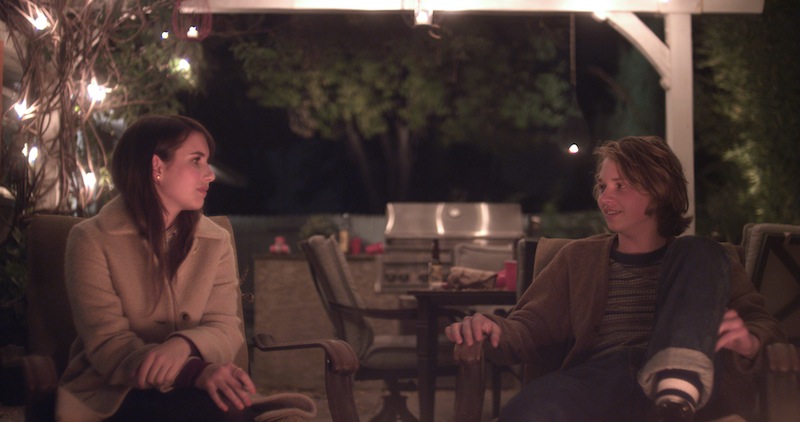
It turns out the only thing that angers Palo Altans more than James Franco’s novel “Palo Alto: Stories” is Gia Coppola’s film adaptation of that book, “Palo Alto.”
The drama, based on a select few of the stories written by Franco in his novel, follows the confusing, angst-ridden life of high school students. April (Emma Roberts) is a quiet girl who plays on the school soccer team. While her parents may be negligent, her coach Mr. B. (James Franco) gives her more than enough attention, appropriate or otherwise. Meanwhile, Teddy (Jack Kilmer) and his dangerously rebellious friend Fred (Nat Wolff) are constantly getting into trouble just for the sake of it.
If the plot sounds bland, that’s because it is. Nothing happens in this film. Perhaps Coppola wanted to simply show section of the lives of these characters, but their problems and actions are so useless the story ends up being average. It’s hard to relate to characters when they do things for no specific reason and barely, or never, learn from their mistakes.
The general explanation of these characters’ actions is their ubiquitously bad parents, but that hardly explains most of what happens in the film. If one of the characters had that problem, and the problem was really focused on, it would be excusable, but that’s not the case. It’s a lazy writing technique, and inspires no love for the characters.
Actually, that would be a good way of describing most of the writing: lazy. Every character besides Teddy and April are archetypal and act without reason or intention. Seriously, how many times are we going to see a high school film with unexplainably malicious popular girls until it gets boring?
To continue the motif of laziness, the film is full of pseudo-deep shots and scenes. The meaning or point of them is implied, but is not actually there. An example: a minute-long shot of April looking out a window is not deep, it’s boring. There’s no content to shots like these; if a character is supposed to be thinking, there are better ways to show that then to let the audience guess.
The one redeeming part of the writing was some of the humor. Most of it consists of stupid, immature jokes, or silly tidbits of dialogue, but its accuracy to the way that high school students act made it amusing. Someone blurting a lame, uninspired insult about their friend’s sexuality isn’t inherently funny – it’s funny because it’s just the kind of obnoxious thing a teenager would do. Once again the issue comes back to laziness, when jokes and gags are repeated.
Performance-wise, the film was acceptable. None of the actors ended up being more than decent because, as good as their performances were, their roles were so boring and melodramatic it gave them few opportunities to actually show their ability.
The film actually had some great moments of camerawork and editing. A lot of the cinematography felt fitting and interesting, especially the shots of suburban night life. The pacing of shots complimented the content of the scenes well. The film seemed to have a high-contrast filter, which really helped the mood. Colors were vibrant and pleasing to look at, which contrasted interestingly with the darker content.
Some residents of real-life Palo Alto have criticized the film for portraying the town in an unfairly negative light, but in reality nothing in the movie is specific or even connected to the actual city. None of Palo Alto’s notable attributes, such as Facebook headquarters or the presence of Stanford, are more than slightly alluded to, and the settings in which the film takes place are clearly not Palo Alto (to a native Palo Altan, at least). The movie was actually filmed entirely in Southern California.
So, rather than specifically criticising the local culture in the manner of “Silicon Valley,” “Palo Alto” is actually meant to serve as a portrait of teenage life anywhere in the country. Its name ends up being little more than a placeholder that could potentially be interchanged with any other town – Palo Alto just happened to be James Franco’s childhood home and therefore the nominal location of his stories. The supposed denigration of the town turns out to be a non-issue; the “shadowy side of Palo Alto” is really just the negative aspects of teenage life everywhere.
In the end, the film offers a generally reasonable but oversimplified look at the adolescent experience. The issues and challenges faced by the movie’s characters are certainly real, but the one-dimensional characters greatly reduce its believability – and there are certain moments of dialogue which simply don’t feel real (not to mention the unrealistically high amount of cigarette smoking by the teens in the supposedly present-day setting of the movie). The film manages to touch on elements of what it is like to be a teenager, but its lack of significant plot or point ultimately prevents it from being more than a pessimistic, apathetic adaptation.
“Palo Alto”
1 hour, 40 minutes
Rated: R for strong sexual content, drug and alcohol use, pervasive language, smoking, all involving teens
Directed by Gia Coppola
Starring: James Franco, Emma Roberts, Jack Kilmer
Based on the novel Palo Alto by James Franco



Trevor • May 29, 2014 at 7:50 am
I haven’t seen the movie yet. The report of one-dimensional characters is disappointing, as high school represents some of the most raw, invigorating, agonizing emotional experiences we have in life. I feel like people were most complex and multi-dimensional in those years, and we’ve managed to simplify our lives (for the better) in years hence. It’s also a bloody shame that they filmed it in Socal, as northern Palo Alto is one of the most gorgeous and charming towns on this planet regardless of the season. Taking on a movie about life at Paly demands skilled, careful screenwriting and casting, and delicate cinematography on the iconic streets of the city in question.
With that said, I’m not sure the plot is necessarily so bland, even if it is a mosaic of teenage angst and melodrama. Franco’s Palo Alto resonated strongly with me as a Paly ’05-er, and those vignettes reflected many of the experiences I shared with my peers while at Paly. I mean, not the Gamble Gardens scene explicitly, but we got into all sorts of trouble at Gamble, Rinconada, Eleanor, Addison, Duveneck, Paly, Newell Road and North/Southhampton, Jordan, parents’ homes, etc after curfew, and those vivid memories of sprinting across wet lawns and cutting across intersections under the streetlights hold far more meaning for me than Stanford (didn’t care to apply) or Facebook (needed a college email address back in my day).
If you look at the recent history of our community, the archetype of privileged suburban teenagers acting out cynically and taking severe risks amidst such staggering opportunity should really be more telling about our high school experience than the presence of top colleges or multi-billion-dollar IPOs, although it’s significant that the authors Drew and Gavin point to those institutions as our notable attributes. No, the question is, why would kids with such tremendous potential squander it on drug addiction, unplanned pregnancy, killing ourselves, and going to prison?
The real story of Palo Alto is about a student body learning to reconcile the desire to be a damn kid with expectations to be global leaders, cross-referenced with an archaic-but-improving district policy around identifying and mitigating mental health crises, reflected by the “plot-less” angst and melodrama you see acted out in those stories.
Paly'12 • May 28, 2014 at 5:26 am
I was at a showing where Ms. Coppola came out after to answer audience questions, and she even admitted that she considered changing the title, which I think really explains how little her film has to do with our town. I thought the constant use of cigarettes was particularly egregious.